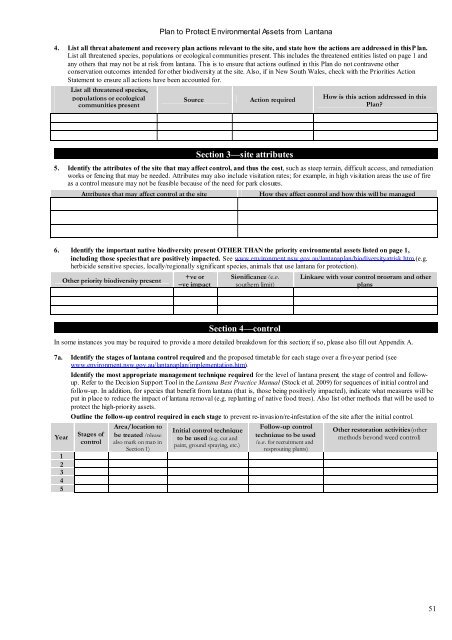Plan to Protect Environmental Assets from Lantana - Weeds Australia
Plan to Protect Environmental Assets from Lantana - Weeds Australia
Plan to Protect Environmental Assets from Lantana - Weeds Australia
Create successful ePaper yourself
Turn your PDF publications into a flip-book with our unique Google optimized e-Paper software.
<strong>Plan</strong> <strong>to</strong> <strong>Protect</strong> <strong>Environmental</strong> <strong>Assets</strong> <strong>from</strong> <strong>Lantana</strong><br />
4. List all threat abatement and recovery plan actions relevant <strong>to</strong> the site, and state how the actions are addressed in thisP lan.<br />
List all threatened species, populations or ecological communities present. This includes the threatened entities listed on page 1 and<br />
any others that may not be at risk <strong>from</strong> lantana. This is <strong>to</strong> ensure that actions outlined in this <strong>Plan</strong> do not contravene other<br />
conservation outcomes intended for other biodiversity at the site. Also, if in New South Wales, check with the Priorities Action<br />
Statement <strong>to</strong> ensure all actions have been accounted for.<br />
List all threatened species,<br />
populations or ecological<br />
communities present<br />
Source<br />
Action required<br />
How is this action addressed in this<br />
<strong>Plan</strong>?<br />
Section 3—site attributes<br />
5. Identify the attributes of the site that may affect control, and thus the cost, such as steep terrain, difficult access, and remediation<br />
works or fencing that may be needed. Attributes may also include visitation rates; for example, in high visitation areas the use of fire<br />
as a control measure may not be feasible because of the need for park closures.<br />
Attributes that may affect control at the site<br />
How they affect control and how this will be managed<br />
6. Identify the important native biodiversity present OTHER THAN the priority environmental assets listed on page 1,<br />
including those speciesthat are positively impacted. See www.environment.nsw.gov.au/lantanaplan/biodiversityatrisk.htm (e.g.<br />
herbicide sensitive species, locally/regionally significant species, animals that use lantana for protection).<br />
Other priority biodiversity present<br />
+ve or<br />
–ve impact<br />
Significance (e.g.<br />
southern limit)<br />
Linkage with your control program and other<br />
plans<br />
Section 4—control<br />
In some instances you may be required <strong>to</strong> provide a more detailed breakdown for this section; if so, please also fill out Appendix A.<br />
7a. Identify the stages of lantana control required and the proposed timetable for each stage over a five-year period (see<br />
www.environment.nsw.gov.au/lantanaplan/implementation.htm).<br />
Identify the most appropriate management technique required for the level of lantana present, the stage of control and followup.<br />
Refer <strong>to</strong> the Decision Support Tool in the <strong>Lantana</strong> Best Practice Manual (S<strong>to</strong>ck et al. 2009) for sequences of initial control and<br />
follow-up. In addition, for species that benefit <strong>from</strong> lantana (that is, those being positively impacted), indicate what measures will be<br />
put in place <strong>to</strong> reduce the impact of lantana removal (e.g. replanting of native food trees). Also list other methods that will be used <strong>to</strong><br />
protect the high-priority assets.<br />
Outline the follow-up control required in each stage <strong>to</strong> prevent re-invasion/re-infestation of the site after the initial control.<br />
Year<br />
1<br />
2<br />
3<br />
4<br />
5<br />
Stages of<br />
control<br />
Area/location <strong>to</strong><br />
be treated (please<br />
also mark on map in<br />
Section 1)<br />
Initial control technique<br />
<strong>to</strong> be used (e.g. cut and<br />
paint, ground spraying, etc.)<br />
Follow-up control<br />
technique <strong>to</strong> be used<br />
(e.g. for recruitment and<br />
resprouting plants)<br />
Other res<strong>to</strong>ration activities(other<br />
methods beyond weed control)<br />
51

















